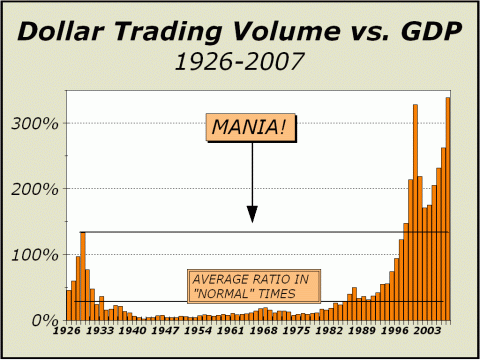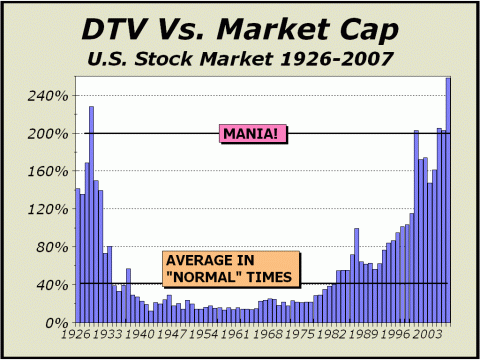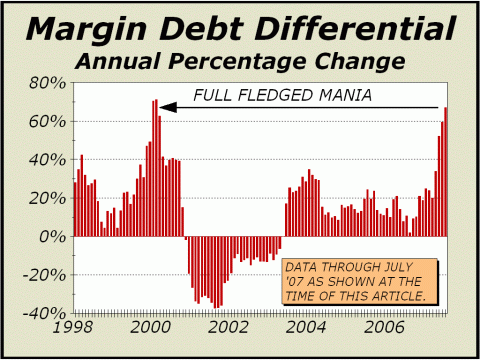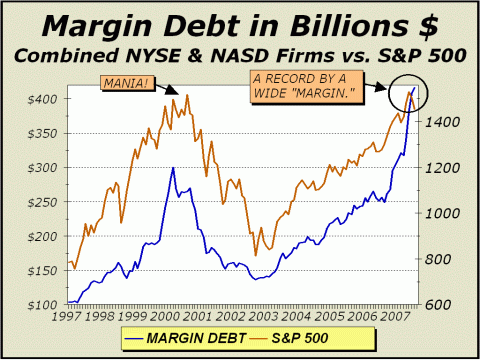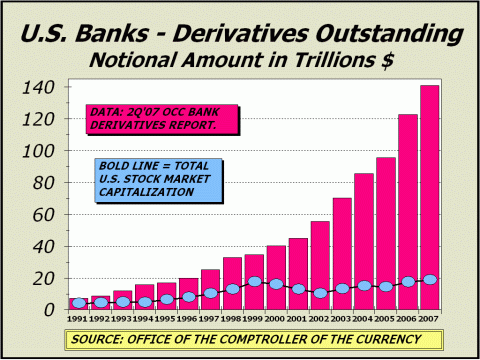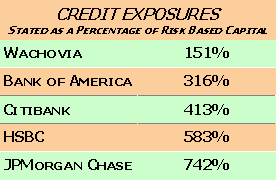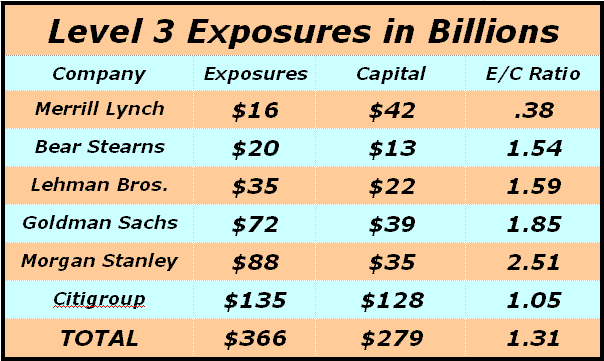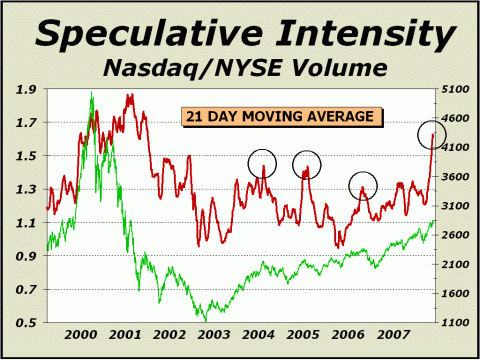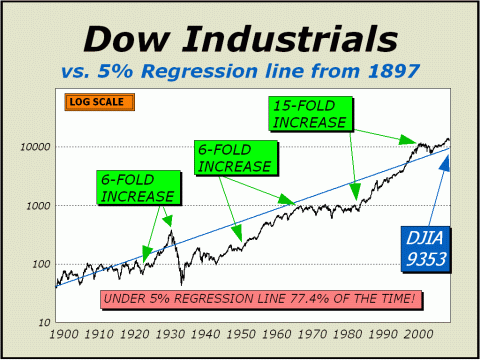
|
- THE GREATEST STOCK MARKET MANIA
OF ALL TIME -
DATED JANUARY 17, 2008 A SPECIAL REPORT BY ALAN M. NEWMAN, EDITOR CROSSCURRENTS This feature is now published on roughly a quarterly basis. Our next update will likely be published in late April 2008. |
|
A world map of readers from 156 countries can be viewed HERE. Run your mouse over each country! This report is now mostly a compilation of articles that have previously appeared in the Crosscurrents newsletter. Our paid subscription stock market newsletter has only two rationales for its existence; powerful commentary and unique perspectives that cannot be found anywhere else. Please check out the testimonials on our Kudos page. To see a free sample copy of the Crosscurrents newsletter, Printable
files of this report are available only to paid subscribers.
In our view, last year's late collapse and the new year's downside volatility have been the result of derivative problems that we have long forecast would occur. The tremendous growth in derivatives has been almost completely unchecked. Transparency has never been an issue and the opaque nature of counterparty risks has always threatened a worst case scenario. While this report will not go into as much depth regarding derivatives as in the past, our prior reports are online and can be perused at your leisure. Below, you will find them listed and linked for your convenience. Archived
report for August 2001
The statistics for total Dollar Trading Volume are becoming more and more difficult to track and we suspect that by now, there is probably no completely accurate method of collating the velocity of trading in the U.S. It now appears to be impossible to track exactly what might be double (or even triple) counted and the presence of so many electronic exchanges brings into question whether some information is simply so buried it cannot be tallied or accurately presented. The NYSE Group now trades Nasdaq, ARCA and Amex issues and NYSE issues are traded on those exchanges, as well as the Chicago, Philadelphia, Boston and others. The information overload is now overkill. Worse yet, the proliferation of so-called "dark liquidity pools," (see tinyurl.com/3946uf or tinyurl.com/2ltpyl, for example) offers concrete proof that many transactions go unseen and uncounted. The latter article claims that 20% of all trades in NYSE listed issues have been funneled through dark pools. As well, the enormous unchecked growth in derivatives has created a situation where it is impossible to measure risk. In the same vein, the increased velocity in unseen stock trading threatens any logical calculation of risk. From the information that is available, our most recent tally of total Dollar Trading Volume stands at a brand new record high, 3% higher than in the manic year of 2000 and two-and-half times as much as the fateful year of 1929. For every dollar transacted on the NYSE in 2003, $2.26 was transacted last year. While we cannot verify our count, we have no doubt as to the veracity of the theme. Trading has taken over. Investment is, for all intents and purposes, dead. As we showed in our September 2007 report on turnover (see "The Death of Investment"), there is ample proof of the increased velocity in trading. A similar picture arises for Dollar Trading Volume compared to total stock market capitalization. The only difference is that a new record high was not recorded in 2000, despite the presence of a mania for stocks. But not only do we see a new record high for 2007, the old record has been convincingly shattered. We have repeatedly pressed our point that the four-and-a-half year bull market from the March 2003 lows was an "echo" of the prior mania and we believe the chart below is proof that we were correct in our assessment.
From 1932 through 1996, a period of 65 years, DTV never exceeded 100% of market capitalization. During those years, average DTV to market cap was only 34.6%. Since 1997, average DTV to market cap has been close to five times higher at 167.7%. What occurred to catalyze the incredible increase in the velocity of trading? The only answer that makes
sense is that participants were
2007 parallels the prior mania of both 1929 and 2000. We are witnessing the unwinding of the mania.
The following article is reprinted from the October 1, 2007 issue of Crosscurrents. "Exposure Exposé" In the August 20th issue, we presented a chart of the three-month percentage change in margin for the U.S. stock market, using tallies that combine both NYSE and NASD firms. The data ran far beyond the top in 2000, illustrating an extremely rapid buildup in leverage exposure. Given that four-and-a-half years had elapsed from the last price correction of any substance, it appears that participants were lulled into complacency. Today's featured chart clearly illustrates that complacency is not only visible on a brief three-month basis, but on an annual basis as well. The building of trust, faith and hope has been an ongoing sensation and has now taken us to very nearly the precise annual percentage gain levels that gave us the top of the greatest stock market mania of all time. Bear in mind that total margin debt, visible in the second chart following, has run to the highest levels ever, by far. Our first featured chart simply reveals how much higher total margin debt is over the course of the last 12 months. Of course, either perspective tells us all we need to know about the U.S. stock market. Exposure to leverage has advanced enormously and stocks are now in a very dangerous environment.
Since the beginning of 1997, total margin debt has increased in 63% of all months while prices have advanced in 59% of all months. Logically, one would expect higher prices to reinforce confidence, resulting in additional margin debt. The correlation is not only clear, it is both intertwined and reinforcing. More margin debt enables higher prices, resulting in even more confidence, and thus additional margin debt and even higher prices. A cycle of expanding leverage and exposure. Of course, the three-year bear market from 2000 to 2003 proved that the cycle also works in reverse. Total margin debt contracted from $300 billion in March 2000 to $136 billion in September 2002, the equivalent of a $164 billion outflow from stocks.
What makes current margin levels even more amazing is that a larger percentage of our total market capitalization is either indexed or otherwise not able to be leveraged than ever before. In 1929, it was not only individuals who were buying stocks on margin, it was the equivalent of mutual funds, the huge investment trusts of the day. However, in the current environment, although hedge funds have certainly contributed to increasing leverage, the mutual fund industry clearly has not and almost all ETFs have not. Mutuals and ETFs together account for 36.7% of all stock assets. Currently, this leaves roughly $11.7 trillion in stock assets capable of being leveraged. The same computation for the March 2000 peak, subtracting mutual fund and ETF assets from total market cap left roughly $13.5 trillion capable of being leveraged. When we apply the manic peak of $300 billion in total margin debt, we find 2.2% was leveraged. Today, with more margin debt
applied to a smaller asset base
We view this as a substantial
increase
We are now witnessing the unwinding of excess leverage.
The following article is also reprinted from the October 1, 2007 issue of Crosscurrents. "Credit Exposé" Twice each year we typically focus the principal portion of our commentary and charts on derivatives; structured and engineered financial products that have the capability to catalyze a financial collapse and subsequently rupture the economy. The proof was quite visible in both 1987 and 1998 and may be on the verge of appearing now as securitized mortgages and credit markets undergo severe stress. In 1987, so-called portfolio insurance was created as a safety net to lessen exposures in a declining market. In its simplest form, if prices declined by 3%, stock futures were sold in order to protect against the ravages of a further decline. In its simplest form, this was probably a good idea. The trouble was, since it probably was a good idea, the use of portfolio insurance spread like wildfire. When the inevitable 3% decline came into play, many utilized the identical course of action and sufficient futures sales were triggered to send prices plunging by another 3%, triggering another round of futures sales and another 3% decline. You get the picture; the cycle was reinforced. There is simply way too much subject matter to cover at this time, hence we only offer this abbreviated commentary on derivatives and a single chart and table. As the picture below clearly illustrates, derivatives continue to grow at a truly awesome pace. We are on target to achieve notional values of $150 trillion this year, a rate of 20% annualized from 1991 and the same rate of growth over the last decade.
The top five banks account
for 97.1% of all derivatives
We are now witnessing the unwinding of huge credit exposures.
The following
article is reprinted from the November 26, 2007 issue of Crosscurrents
"So Many Questions, So Few Answers" According to Tony James, president of the Blackstone Equity Group, "The mortgage black hole is, I think, worse than anyone saw. Deeper, darker, scarier. [The banks] are now looking at new reserves and my sense . . . is they don't have a clear picture of how this will play out and confidence is low." The story was reported by ft.com’s James Polito (see http://tinyurl.com/2mukbg) on November 13th. Despite the reference to a "black hole," James claimed that subprime mortgage prices were reaching a point where they offered "real value." The apparent contradiction is actually more of a reflection of the derivative mess than the housing market. As we have stated for the last several years, the rush to securitize literally everything under the sun has placed both banks and brokers in a very risky position, with so-called Level 3 assets that are so opaque that they cannot be “marked to market” since there is no readily traded market for the assets. The FASB recognized the problem and new accounting rules that just went into effect will make it far more difficult to value Level 3 assets as before, when as some commented, they were “marked to make believe.” On November 8th, Reuters (see http://tinyurl.com/2mm9ld) reported a headline "Credit crisis worse than LTCM," quoting Jack Malvey, chief global fixed income strategist at Lehman Brothers. Given that the LTCM debacle probably brought the country to the precipice of a total financial collapse only nine years ago, Malvey's declaration was nothing short of stunning. Walden Siew's article goes on to quote Malvey, "This is so dispersed, so interlocked and the relationships among the various entities are not as evident. This is a painful lesson in financial engineering." Incredible. Q: how many times in the past have we reported this would eventually be the case? A: dozens. In the April 2nd issue, we discussed the risks in detail and followed up briefly in October 1st issue. On many occasions we claimed it was not a matter of if, but when. The time has come.
Lest no one misunderstand, this crisis is in derivative contracts. There is no doubt whatsoever that like Nasdaq, housing was on a tear, fueled by easy money, and is now in the midst of a significant correction, not unlike 1990-1991. However, we do not believe that anything dire is in the wind for housing, although California’s mania still rates special attention and concern. We can only reiterate that people who live in houses typically will do everything they can to remain in them. Derivative contracts offer no shelter. On November 7th in the Wall Street Journal online (see http://tinyurl.com/2rncur), Dana Cimilluca reported "$500 Billion: The Mother of All Write-Down Estimates," quoting one bank analyst on the potential extent of the credit crunch. In the interests of fairness, we feel compelled to point out the estimates of damages are as few as $100 billion, such as reported by John Gover on Bloomberg (http://tinyurl.com/2hu2u8). We recently saw stats claiming Bear Stearns "adjusted" leverage was 15.5 times its capital, while Goldman Sach's gross leverage ratio was 24.5 times capital. There are of course, dozens of others in similar straits, viewable in the charts of all the major banks and brokers. That's how you get to potential damages in the hundreds of billions. Our take is that all the guesses are just that—guesses. No one can possibly have a handle on the total impact since the daisy chain of derivative contracts involved are so convoluted and interwoven. The charts say that we are far from out of the woods. Indeed, this journey appears to have a ways to go. Worse yet, the scare has now gravitated to money market funds, supposedly safe harbors for investors' cash reserves. Eric Dash's NY Times story (see http://tinyurl.com/yrjowz) points out that some management firms are now in handstand mode, doing everything they can to protect the sacred dollar per share price of their money funds. Trouble is, some have invested in toxic CDO's and SIVs that are worth far less than their purchase price. Stock market bulls have long believed that the trillions in money funds represented fuel for the next leg of the bull market., but if concerned investors begin pulling money out of the money markets, the supposed fuel will quickly go up in smoke. The danger doesn't stop there. The situation has become so dicey that any sense of predictability has gone out the window. A federal judge in Ohio recently dismissed 14 foreclosure actions, claiming the original documentation for the mortgages was missing. As one NY Times article suggests (see http://tinyurl.com/2tbxzt), "...in the process of securitization these documents are often lost. And with many servicers going out of business....these documents are lost in their abandoned offices." Upshot: the legal standing of investors in mortgage securities pools are now in question! There is nothing the stock market hates more than uncertainty. At present, there is as much uncertainty as this writer has seen in more than 40 years. The questions are many. Has the derivative crisis peaked? Is the table on page one simply a list of risk exposures or will some of the major players completely implode? Will the damage extend to money market funds? If so, how much pension money is at stake? How much of the average investor’s cash reserves will be impacted? Most likely, the answers will take months to take shape and in the meantime, we expect uncertainty to rule. At best, we expect the remainder of the correction we forecast months ago to eventually unfold. At worst, the stage was set for the unwinding
of the
We are now witnessing the unwinding of uncertainties.
The following article is reprinted from the November 6, 2007 issue of Crosscurrents. "Fanciful Flights To Safety" Keynes said it best, "....the market can remain irrational longer than you can remain solvent." Clearly, even prescience of the year's events would have done little for a conservative soul or especially, a skeptic. For the moment, let's assume that back in January, we had known the following would occur. 1) Margin debt soaring to record new highs, exceeding the 2000 peak by close to 40%. 2) The Mutual fund cash-to-assets ratio falling to the lowest level in history. 3) A credit crunch precipitated by the collapse of structured bond products consisting of mortgages in an environment of rising foreclosures. 4) A collapse of several market neutral hedge funds. 5) Crude oil prices rocketing to more than $96 per barrel. 6) Recession odds rising to as high as 50%. 7) Gold over $800 per ounce. Although numbers 1 & 2 would certainly support higher stock prices, one would infer phenomenal risk as a result and an eventual price correction far greater than the actual 9.4% August decline. For over a century, a 10% or greater correction could be expected to occur every 15 months on average, yet the last correction of that magnitude occurred more than four-and-a-half years ago. In the past, this would have been termed a Goldilocks scenario. Trouble is, as evidenced by the odds for recession (see http://tinyurl.com/2mfhtk), Goldilocks already left the room and threatens to be away for awhile. Again, as we witnessed at the manic peak of 2000, the most overvalued stocks seem to be the drivers of optimism. A recent look at the Nasdaq Powershares Trust (QQQQ) reveals that since the August bottom, Apple (AAPL) and Google (GOOG) have been responsible for fully one-third of the gains, although the two issues only represent 13% of the Trust's capitalization, which consists of 100 stocks. Stated another way, we can clearly make the case that the rest of Nasdaq is not performing as well as the various indexes imply. When Research in Motion (RIMM) was added to the calculation in Alan Abelson's recent Barron's column, the three stocks were responsible for roughly one-half of the Q's gains. When advances are broadly based, a true bull phase is in progress and further gains can be expected. However, when advances are narrow, the bull phase is typically close to an end and is not worthy of our trust. When advances are as narrow as now, there should be only one consideration, risk and the implications of danger ahead. In the September 10, 2007 issue of Crosscurrents, we wrote about "The Death Of Investment," citing the relative complete absence of investment in today's stock market, seemingly totally dominated by a trading mentality. As evidence, we cited the ever decreasing holding periods for individual stocks and especially, exchange traded funds. Laughably, ETFs (such as the Nasdaq 100 Trust) are advertised as "diversified, long term investment approaches," despite average holding periods brief as 2.39 trading sessions, or in more precise terms, 15 hours and 32 minutes. Long term?! It's not quite as bad for the individual constituents of the ETFs but it is nevertheless, startling evidence that the theme of investment has indeed, shuffled off this mortal coil. We computed turnover for GOOG, YHOO, AMAT, LVLT, SUNW and AAPL in the September 21st issue but truth be told, the list was totally arbitrary and somewhat randomly chosen and last week we were prodded to look at a few others, like RIMM. Turns out that RIMM's turnover is second to AAPL's. While AAPL's average holding period comes in at 23 trading sessions, RIMM's is a tad more at 25 sessions and Google’s is relatively long term at roughly 42 trading sessions. The metamorphosis of the U.S. stock market continues, unimpeded by logic or reason. While one may attribute that fair values must arise when the vast majority of investors consider the long term prospects of individual corporations, one may also impute the opposite; that fair values are not at all a consideration when stocks function primarily as trading vehicles. If fair values are not considered by participants, then the odds favor that fair values can only be achieved by accident. Check out our featured chart below, which illustrates how Nasdaq is taking up a larger proportion of the action. It is no wonder that the Naz is providing most of the excitement in 2007 and no wonder that the huge turnover witnessed in stocks such as Apple and Google is providing a significant boost to Nasdaq's performance.
In what may be the most amusing circumstance
in stock market history,
While they may continue to provide a small
measure of relief over the intermediate term,
We are now witnessing the unwinding of speculation.
In our last report, we said "Our favorite chart of market potential has become the Dow Industrials versus a 5% regression line imposed since 1897, a period of 110 years." We see no reason to show another perspective since this one illustrates market potential so perfectly. That said, another of our favorite long term measures has recently taken on a new character. Ten-year rolling annualized average gains have fallen UNDER 5% for the first time since January 31, 1986!!! Stocks can only return just so much over any protracted period of time. They are neither the perfect long term investments nor are returns ever guaranteed. The six-fold increase in the Roaring Twenties was followed by a crash and a very long period of underpeformance. Likewise, so was the six-fold increase in the secular bull market that ended with the terrible 45% drubbing suffered in 1973-1974. The Dow increased fifteen-fold from 1982 to 2000, the most spectacular long term climb in history. By the time the peak was registered by Nasdaq in March 2000, it could fairly be assumed that anyone who was ever going to be in stocks was already in stocks. With no one left to buy, there could only be one result. Down. We expect a very long period of underperformance to bring long term results in line with the past. Given that our chart shows an UNinterrupted period of 66 years where the Dow traded under the 5% regression line, we believe logic dictates a return to "average." We are not predicting a similar period where returns are under the regression line but we do expect an eventual return to the regression line. Again, as we said in our last update, "we believe that going forward, the line may now represent a worst case for a bear market. The good news is this means the October 2002 lows should represent the secular bear market lows and will very likely not be violated."
Again, the bad news is that we expect an eventual return journey to the regression line. The regression line now stands at 9353, about 25% below the recent Dow lows. If it takes five full years to achieve the regression, the Dow will trade at 11,937, still 4.5% below the recent lows and more than 15% below last year's highs. In fact, if the Dow touches
the regression line six years from today,
The great unwinding is in progress.
The action in financial issues over the most recent months indicates vast troubles in the financial system. The last two occurrences where derivatives played a major role were in 1987 and in 1998. The former led to a stock market crash. The latter nearly led to a financial collapse. The unwinding of current derivative problems is expected to take many months and continue to seed doubt and uncertainty......the bull market from late 2002 to 2007 has concluded.
High
Targets for 2008
Highs likely to occur late in the year Low
Targets for 2008
In our
view, the odds still imply a 15% correction
THE CONTENTS OF THE ENTIRE WEBSITE ARE COPYRIGHT 2008 CROSSCURRENTS PUBLICATIONS, LLC I hope you have enjoyed your visit and please return again. If you know anyone who might be interested in seeing what we have to offer, we'd be happy to have them visit as well! Alan M. Newman, January 18, 2008 
CLICK ICON TO GO BACK TO ARCHIVE MENU All information on this website is prepared from data obtained from sources believed reliable, but not guaranteed by us, and is not considered to be all inclusive. Any stocks, sectors or indexes mentioned on this page are not to be construed as buy, sell, hold or short recommendations. This report is for informational and entertainment purposes only. Persons affiliated with Crosscurrents Publications, LLC may be long or short the securities or related options or other derivative securities mentioned in this report. Our perspectives are subject to change without notice. We assume no responsibility or liability for the information contained in this report. No investment or trading advice whatsoever is implied by our commentary, coverage or charts. |
